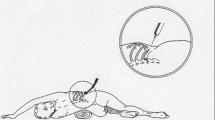Abstract
As it is known, paraplegic and quadriplegic patients are at an increased risk for urolithiasis. We have studied the effectiveness of extracorporeal shock wave lithotripsy (ESWL) in 15 patients with spinal cord dysfunction who were treated in our ESWL unit. A total of 23 treatments were performed. The number of shock waves ranged between 1500 and 3000 per treatment. Only 1 and 3 patients were stone-free at one-month and 3-month follow-up, respectively. Ten of 15 patients with long-term follow-up of 6 to 20 months were stone-free. The remaining 5 patients with residual fragments had staghorn calculi or stones larger than 2.5cm.
We conclude that ESWL is an effective and well tolerated method for this population but the fragment clearance is delayed and below that for unselected patients.
Similar content being viewed by others
References
Chaussy, C., Schmiedt, E., Jocham, D., Schuller, J., Brandl, H., Liedl, B.: Extracorporeal shock wave lithotripsy (ESWL) for treatment of urolithiasis.Urology (Suppl. 5),23, 59 (1984).
Commarr, A. E., Kawaichi, G. K., Bors, E.: Renal calculosis of patients with traumatic cord lesions.J. Urol., 87, 647 (1962).
Drach, W. G., Study Coordinator, Rether, S., Fair, W., Finlayson, B., Gillenwater, J., Griffith, D., Lingeman, J., Newman, D.: Study Group. Report of the United States cooperative study of extracorporeal shock wave lithotripsy.J. Urol., 135, 1127 (1986).
Head, H., Ribboch, G.: The autonomic bladder, excessive sweating and some other reflex conditions in gross injuries of the spinal cord.Brain, 40, 188 (1917).
Lazare, J., Saltzman, B., Sotolongo, J.: Extracorporeal shock wave lithotripsy treatment of spinal cord injury patients.J. Urol., 140, 266 (1988).
Niedrach, L. W., Davis, R. S., Tonetti, F. W., Cochett, A. T. K.: Extracorporeal shock wave lithotripsy in patients with spinal cord dysfunction.Urology, 38, 152 (1991).
Petterson, H. G., Tiselius, N.: Are prophylactic antibiotics necessary during extracorporeal shock wave lithotripsy?Br. J. Urol., 63, 449 (1989).
Smith, P. H., Cook, J. B., Robertson, W. G.: Stone formation in paraplegia.Paraplegia, 7, 77 (1969).
Sofras, F., Karayannis, A., Kostakopoulos, A., Delakas, D., Kastriotis, J., Dimopoulos, C.: Methodology, results and complications in 2000 ESWL treatment.J. Urol., 61, 9 (1988).
Spirnack, J., Bodner, D., Udayashanker, S., Resnick, M.: Extracorporeal shock wave lithotripsy in traumatic quadriplegic patients: Can it be safely performed without anesthesia?.J. Urol., 139, 18 (1988).
Author information
Authors and Affiliations
Rights and permissions
About this article
Cite this article
Deliveliotis, C., Picramenos, D., Kostakopoulos, A. et al. Extracorporeal shock wave lithotripsy in paraplegic and quadriplegic patients. Int Urol Nephrol 26, 151–154 (1994). https://doi.org/10.1007/BF02768278
Accepted:
Published:
Issue Date:
DOI: https://doi.org/10.1007/BF02768278




